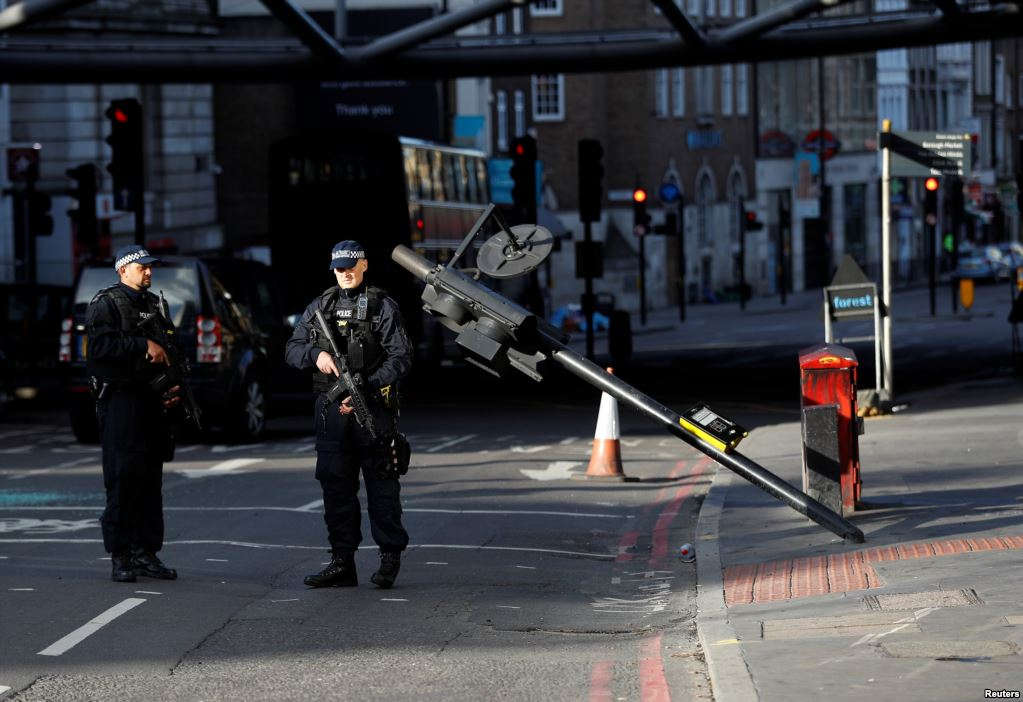Jack Applebee was smoking a cigarette outside his fish restaurant in Borough Market when a woman ran towards him, shouting: “It’s a terror attack, run!”
Applebee sprang into action. He told customers and staff to get to the back of the restaurant, but as he was trying to pull the shutters down to protect them, he found himself face-to-face with two of the three attackers, who ended up killing eight people that night.
“I went to get the keys to get the shutter down immediately. I looked to my right and I saw two terrorists standing on the doorstep there. Just looking at me. I’ll never forget that image, I just thought ‘Shit, I’m done’.
“There was so much hate in their eyes, blank hatred. It was like they were on a path to destruction.”

Just moments before, Khuram Butt, 27, Rachid Redouane, 30 and Youssef Zaghba, 22, had ploughed a white van into pedestrians on London Bridge, and then ran through to Borough Market, on the southern side of the embankment, stabbing Saturday night revellers with 12-inch ceramic knives.
The three men, who were later revealed to have been pumped up on steroids during the attack, were shot and killed eight minutes after the police were called to the scene. It was over in a quick but devastating flash.
After locking eyes with Applebee the men ran on. Police think it was because the people gathered in the restaurant had formed too large a group to target – allowing the restauranteur to pull the shutters down to the mayhem unfolding on the street.
Several people armed themselves with kitchen knives for fear of the men returning, while staff handed out wine to try and calm their nerves.
“Yeah, pour that down, mate,” Applebee remembers them saying. “[The staff] were really trying to make it as light-hearted as they could.” As they calmed customers on the upper and lower floors of the restaurant, gun shots rang out from outside. “We thought it was a war going on, it was bonkers,” he said.
In the year since the attack, which saw Christine Archibald, 30, Xavier Thomas, 45, Alexandre Pigeard, 26, Sara Zelenak, 21, Kirsty Boden, 28, Sebastien Belanger, 36, James McMullan, 32, and Ignacio Echeverria, 39, lose their lives, Applebee says the experience has drawn the people from the local area “together as a family.”
“Fortunately for us, no one here was harmed. We were some of the lucky ones.”
In the weeks after the attack, a giant makeshift memorial to the dead grew at the foot of the bridge – with hundreds of flowers piling up on the pavement from Londoners, many of whom drink Borough’s bars, or commute through the busy railway station.
Applebee said just one of the lasting effects of the tragedy is an increased police presence. “There are so many police around here, undercover and not, to make sure that these kind of events don’t happen again. Which is very positive, it certainly makes you feel a lot better.”
The London Bridge attack came in a summer that had already been marred by tragedy. Attack in Westminster and Manchester, as well as the bombing of a Tube train at Parsons Green in London, and a van attack on pedestrians outside a mosque in Finsbury Park, had taken their toll.
The Prime Minister, Theresa May, responded by vowing to clamp down on hate preaching and the spread of extremist ideology online. She also promised to review the powers held by police and security agencies, suggesting that jail sentences for extremism-linked crime could also be lengthened.
But when news of London Bridge began to break on Saturday June 3, it reignited yet again the question of how to police such a large city from the threat of terror.
In December the director general of MI5, Andrew Parker, told the Cabinet a total of nine Islamist terrorist plots had been thwarted in the UK over the past year. Bollards have now been installed on bridges across the capital, to help halt car attacks like the ones on London and Westminter bridges in 2017.
But PC Tom Hussey, who works with on the City of London’s Project Servator, which deploys hundreds of specially-trained officers across London to areas that could be targeted by a terror attack, says the public also needs to play an active role.
The UK’s terror threat level remains at “severe”, Hussey said Londoners need to be the eyes and ears of the capital. “Any little piece of information is valuable and no matter how unimportant somebody may see that information, it may be the piece of the puzzle that we are missing to stop a terrorist attack,” he said.
On Sunday, a minute’s silence will be held at 4.30pm to mark a year since the terrorist atrocities in London Bridge and Borough Market.
On Friday, in a more positive development to mark the anniversary, a police officer who was stabbed in the head while fighting off the three attackers announced he was hoping to return to work next month.
Wayne Marques, an officer with the British Transport Police, said he had made great progress and was able to walk by himself again after the wound that left him temporarily blinded.
He said in the months he had been in recovery, he had been buoyed by support from the public. “You’ve never met them and you never will, in most cases. But just genuine, heartfelt, caring messages,” he said ahead of the one-year anniversary.
Hussey said the tributes on Sunday are an important reminder for Londoners – and the police – of how important it is for the local community to pick itself up and carry on.
“The aim of the terrorist is to stop us from going out and enjoying ourselves. And that’s the last thing we want to happen.”

